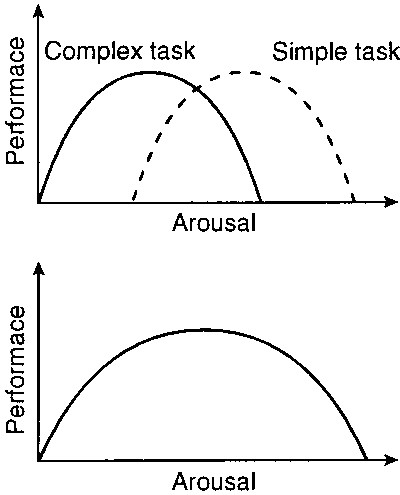Inverted U Theory

Yerkes and Dodson (1908)
At low levels of arousal, performance will be below par, the athlete is not psyched up.
As arousal increases so does performance, up to an optimal point. After this point, further increases in arousal lead to declines in performance.
Each athlete has their own optimal level of arousal. Optimal arousal is higher for more simple tasks and lower for more complex tasks.
An increase in arousal causes improvement in performance up to an optimal point (moderate arousal level). After this point, increased arousal leads to deteriorated performance.
This theory accounts for some of the criticisms of the drive theory and this inverted ‘U’ relationship exists in a number of different circumstances:
Activity type – fine movements & complex skills (which require large amount of attention) require a lower arousal level, e.g. putting in golf / snooker shots / pistol shooting (high arousal interferes with fine muscle movement, co-ordination & concentration). Whereas tackling in football or rugby requires a high level of arousal (which helps skills requiring speed or strength).
Level of expertise – a beginner needs only very low levels of arousal to perform well. Because control of the skill is not yet automatic, i.e. a novice may lose concentration or become anxious, therefore low levels result in optimum performance. In contrast, such low levels of arousal will have no effect on the elite performer, who needs much higher levels to produce optimum performance
Personality – personality types who enjoy high levels of excitement & are generally more extrovert can cope in a high-arousal situation. People who are more introverted are general more likely to perform well under low-arousal conditions.
Problems with inverted 'U' Theory
- Critics question if optimal arousal always occurs at the mid-point of the curve.
- One curve does not explain the different optimal levels of arousal needed for simple and complex tasks.
